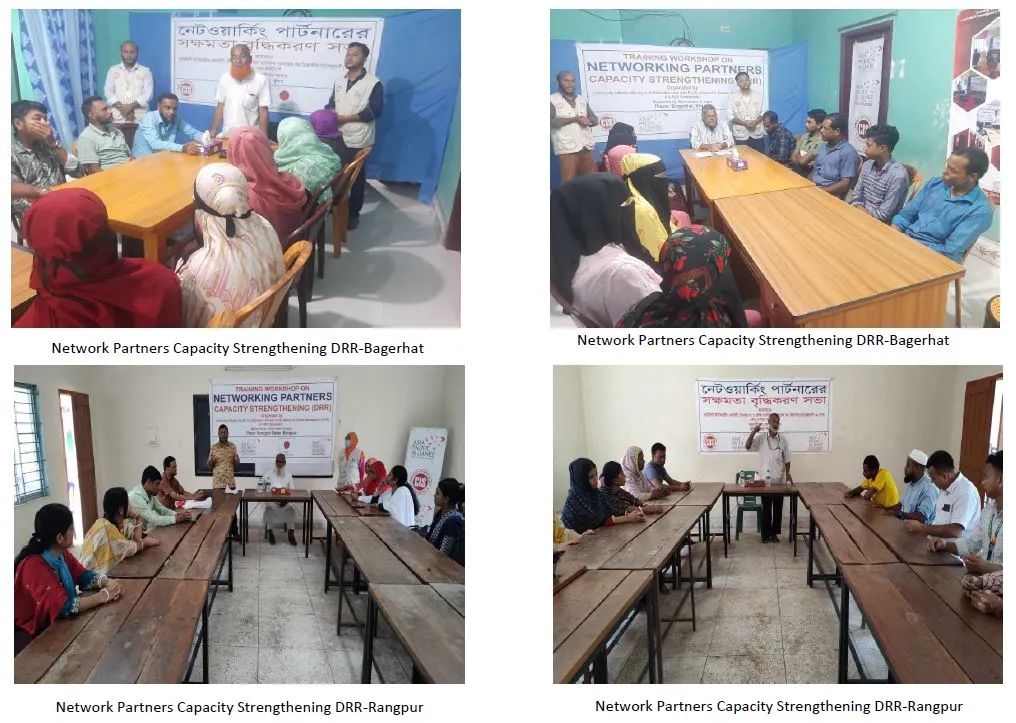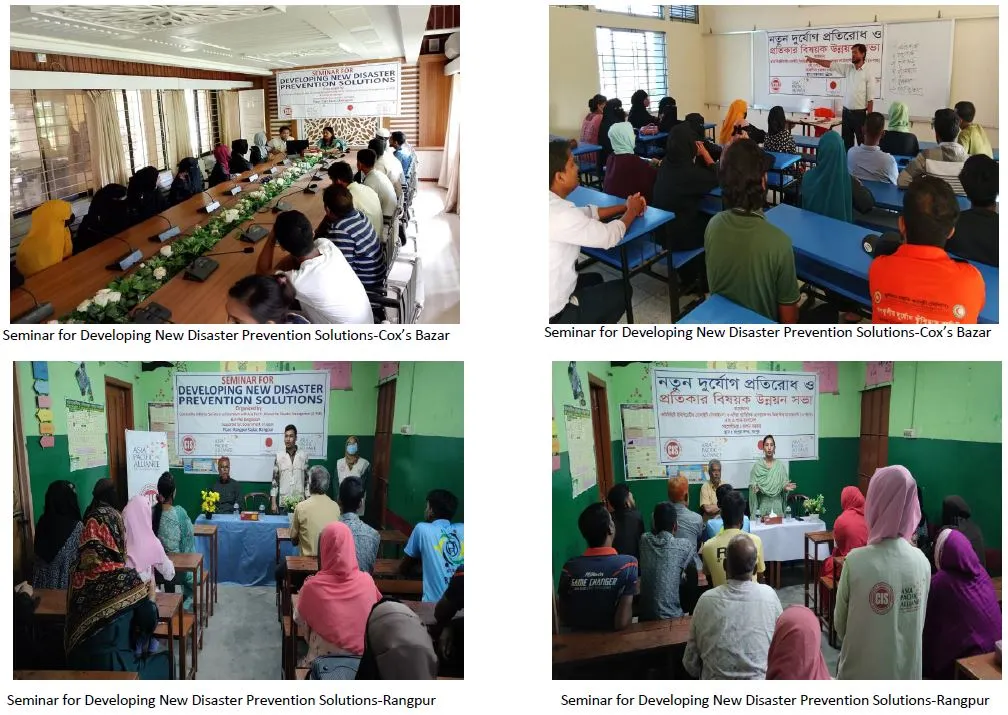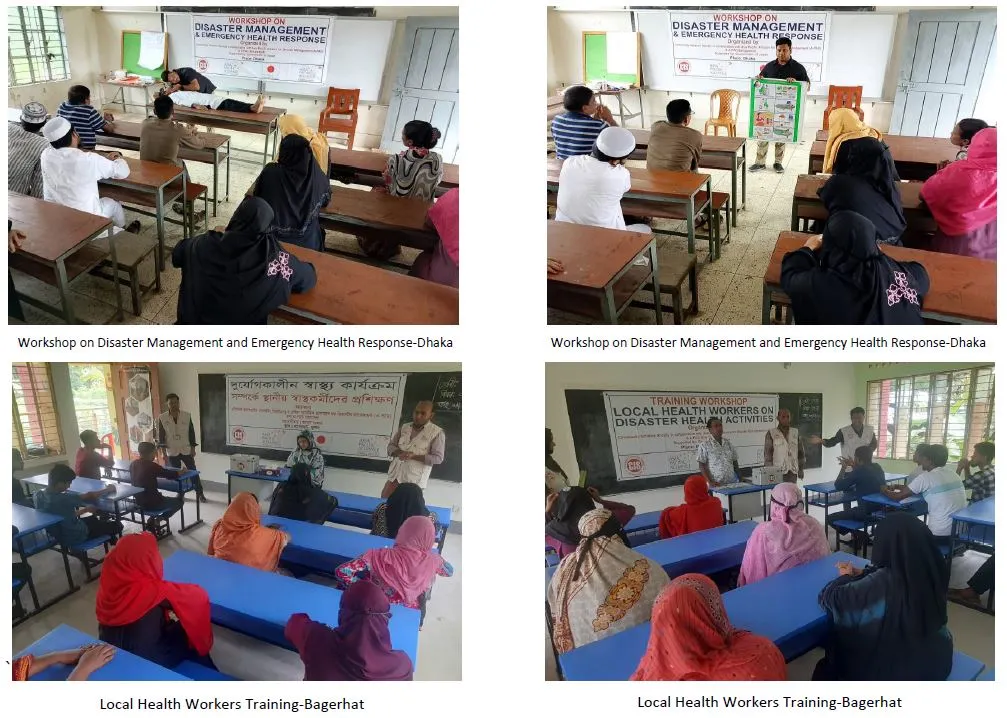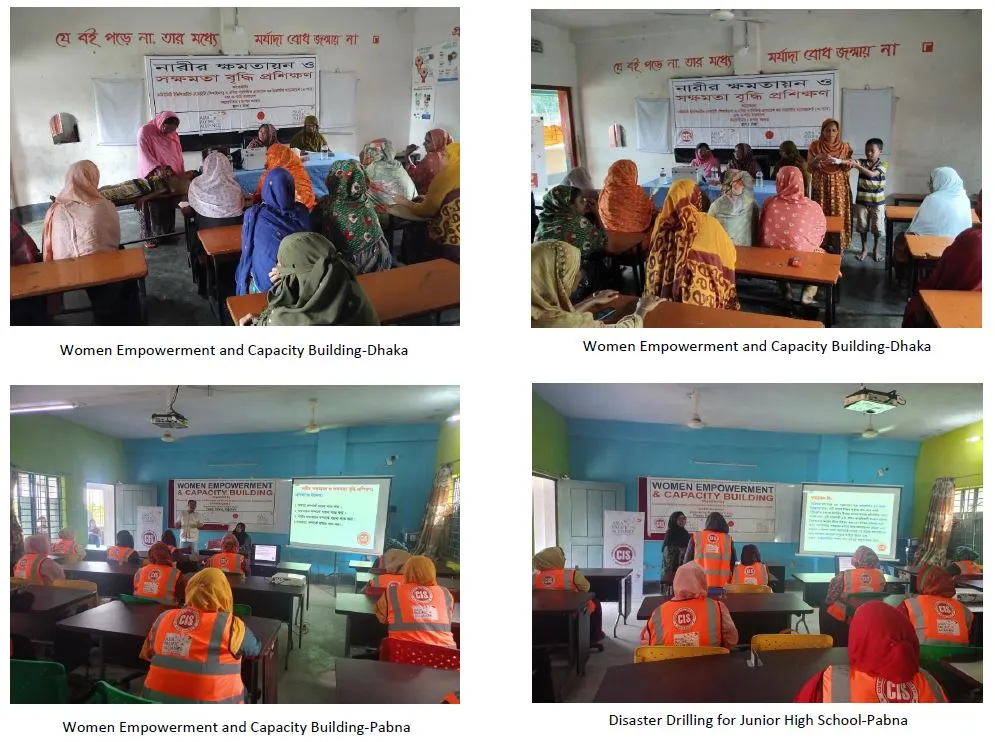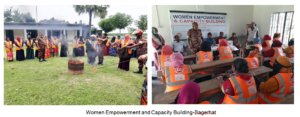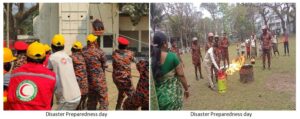Project Title: Strengthening Capacity for Sustainable Disaster Management Network by involving multi-sectoral platform Project Period: 17 January, 2024– 16 January, 2025 (12 month)
- Project Activities and Accomplishments
Bangladesh is ranking as one of the most disaster-prone countries. People in Bangladesh are often affected by water-related natural disasters, including floods, riverbank erosion and cyclones. In addition, recent rapid urbanization increases the risks for earthquake as well as man-made disasters. National Plan for Disaster Management (NPDM) 2021-2025 exemplified the strategic plan of the Government of Bangladesh in its Vision and the Mission of the Ministry of Disaster Management and Relief (MoDMR) between 2021 and 2025 towards building resilient nation. Bangladesh GOVT. has NPDM 2021-2025 has core goals for actions to save life, reduce economic losses in every disaster cycle stages which includes Disaster Risk Reduction (DRR), Humanitarian Response and Emergency Recovery Management. In Bangladesh most hazards impact: flood; cyclone and surge; tornado; earthquake; riverbank erosion; landslide; salinity intrusion; drought; tsunami; lightning; arsenic contamination; human-induced hazards and health hazards. The last hazard has potential for assuming significance because of the emerging risks in Bangladesh.
A-PAD Bangladesh started project from January 2023 and presently continue it 17 January 2024 to build up capacity on disaster management. It communicates with the different sectors like local community, community leaders, stakeholders, GOVT. officials continuing training on disaster management. To hold training program A-PAD Bangladesh staff organized small community meeting to sharing ideas on disaster and introduced them about A-PAD Bangladesh activity. A-PAD Bangladesh working 8 divisional areas.
There are 1 health workers in each divisions whose are doing home visit and aware the local community about basic disaster awareness. The health workers gave basic ideas about disaster management. A-PAD Bangladesh working at the rural areas. If there would be any directions or announcement from GOVT. or any disaster related news has been published the health workers delivered the message to the local community. Total 3,360 persons were benefited from A-PAD Bangladesh on September 2024.
A-PAD Bangladesh attended coordination meeting at the 8 divisions in Office of Deputy Commissioner. At that meeting different NGOs had joined and explained their activities. Besides this what will be the next activities of the GOVT. and NGOs were discussed at that meeting.
1. Strengthening of disaster risk reduction and disaster response system functions through the Emergency Disaster Management Coordination Center | ||
Activities | ( Outcome 1 ) The Emergency Disaster Management Coordination Center operated under this project will function as a disaster response base in each region, leading to the disaster risk reduction in the community and the strengthening of its disaster response system.: | Project Status: Achievements vs Outcome: If the activity is behind the schedule, please write the reason. |
1-1 Operation of Emergency Disaster Management Coordination Centers Target:Local communities 10 people×25 days×8 divisions×12 months =24,000 people | 【Indicators of Outcome】 1-1 The Emergency Disaster Management Coordination Center will be used for coordination meetings among partner organizations and relevant stakeholders during normal times, and will also serve as a center for health and public health guidance for the local residents. In the time of emergency, health services will be provided by emergency health workers. The Emergency Disaster Management Coordination Center will be used by 24,000 local residents (annual average) in the target area. (Indicator:number or visitors, record of services provided) 1-2 Through the Disaster Management Awareness Program, community residents will receive the latest disaster information and knowledge on how to respond to disasters, and people’s awareness of disaster prevention and response will be increased. (Indicator:Community disaster preparedness report) | Total 2,230 people visited to the Disaster Management Coordination Center to discuss about disaster preparedness and health related issues. Dhaka: 270 Persons Cox’s Bazar: 290 Persons Pabna: 302 Persons Bagerhat: 278 Persons Patuakhali: 230 Persons Habiganj: 270 Persons Rangpur: 280 Persons Netrokona: 310 Persons Total = 2,230 Persons |
1-2 Disaster Management Awareness Program Target:Local communities, Community leaders, Local NGOs, Private company workers, government officials 15 people × 8 divisions × 4 times ×12 months =5,760 people | A-PAD Bangladesh conducted Disaster Management Awareness programs at the 8 divisional areas where 497 persons have participated. Total 4 times training organized at each divisional areas. Dhaka:15 Participantsx 4 Sessons= 60+2=62 Participants Cox’s Bazar: 15 Participantsx 4 Sessons= 60+5=65 Participants Pabna: 15 Participantsx 4 Sessons= 60+3=63 Participants Bagerhat: 15 Participantsx 4 Sessons= 60 Participants Patuakhali: 15 Participantsx 4 Sessons= 60+2=62 Participants | |
Habiganj: 15 Participantsx 4 Sessons= 60 Participants Rangpur: 15 Participantsx 4 Sessons= 60+3=63 Participants Netrokona: 15 Participants x 4 Sessons= 60+2=62 Participants | ||
2. Expansion of disaster management network to improve community vulnerability | ||
(Outcome 2)The network of NPF will be expanded and the capacity of each region for disaster prevention and response will be strengthened. | ||
2-1 Network Partner Meeting Target : Local communities, Community leaders, Local NGO, Private Company Workers, Government officials 50 people × 5 villages × 8 divisions = 2,000 people | 【Indicator of Outcome】 2-1 Strategies, mechanisms, and action plans for disaster reduction cooperation are developed in each region through discussions at network partner meetings, and a framework for disaster reduction cooperation is established. (Indicator:Strategic Plan) 2-2 MOUs signed with at least 5 new organizations, including private companies, in A-PAD Bangladesh NPF to expand the network (Indicator:number of new MOUs signed) 2-4 Resources possessed by A-PAD BGD partner organizations are provided in emergency disaster response, and play the role of that organization in times of emergency. (Indicator:List of resources such as supplies, human resources and donations provided by partner | The networking partner meeting was organized in 5 places in Bagerhat . The meeting was conducted at 5 villages where different contents had been discussed so that people from the local community, community leader, GOVT. officials and stakeholders focused on different sectors of disaster management. Total 266 participants joined the Network Partner Meetings. 21-09-2024, Rasulpur , Total Participants 50+5= 55 Participants 22-09-2024, Bakultala, Total Participants 50+2=52 Participants 23-09-2024, Malia Rajapur, Total Participants 50+4= 54 Participants 24-09-2024, Rajiour, Total Participants 50+2=52 Participants 25-09-2024, Nolbuniya, Total Participants 50+3= 53 Participants The network partner meeting, which took place from 21th September to 25th September aimed to facilitate the exchange of ideas and the creation of a comprehensive plan for Disaster Management. This workshop was meticulously designed to identify and address every critical factor and |
organizations for emergency disaster response) | issue essential for successful Disaster Management. The | |
primary focus of the training was to emphasize outcomes | ||
crucial for the successful implementation of the project. The | ||
objective of the Networking Meeting was to strategically | ||
enhance the coordination role of Sarankhola, Bagerhat in | ||
directing and ensuring the effectiveness of disaster risk | ||
reduction and climate change activities. The meeting was | ||
well-attended, with participants including a local | ||
Government NGO Representative, community leader, and | ||
teachers. The agenda for Sustainable Development | ||
underscored the significance of disaster risk reduction (DRR) | ||
and made explicit reference to the intricate interactions | ||
between disasters and poverty, access to healthcare, water | ||
supply, development, climate change, and the preservation | ||
of ecosystems. Furthermore, the meeting highlighted the | ||
importance of understanding disaster risk in terms of | ||
vulnerability, capacity, exposure of persons and assets, | ||
hazard characteristics, and the environment. The five-day | ||
Networking Partners Meeting encompassed different topics, | ||
with a primary focus on disaster risk reduction. The sessions | ||
addressed various crucial aspects, such as cyclones, floods, | ||
lightning, fire issues, as well as government initiatives and | ||
activities aimed at improving the livelihoods of coastal area | ||
residents. The collaboration between public and private | ||
sectors was emphasized as a means to enhance people’s | ||
capacity and contribute to the creation of a sustainable | ||
society. | ||
2-2 Disaster Preparedness | ||
Campaigns | ||
Target:Partner |
organizations and local communities 50 people × 2 times × 8 divisions = 800 people | ||
2-3 Network Partners Capacity Strengthening (DRR) Target : Partner organizations 20 people × 2 organizations × 2 times × 8 divisions = 640 people | A-PAD Bangladesh organized Network Partner Capacity Strengthening DRR at 2 divisional areas Bagerhat and Rangpur. 04-05 September 2024, Bagerhat, Total Participants 40+3= 43 Participants 21-22 September 2024, Rangpur, Total Participants 40+4= 44 Participants Bagerhat district is one of the disaster-prone areas in Bangladesh, facing cyclones, tidal floods, erratic rainfall, cold waves, arsenic contamination, and tornadoes due to its geographic location and weather conditions. A training workshop held on 4th and 5th September 2024 focused on building capacity for emergency response during and after disasters. The workshop had 43 participants from NGOs, including Gonoshakti Kendra and Sarankhola Foundation, addressing disaster awareness, education, and resilience building in cyclone-prone coastal regions of Bangladesh. During super cyclones, many people were unaware of the impending disaster and lacked access to shelter, resulting in loss of lives and difficulties in accessing clean water and medical facilities, as well as maintaining social distance. The two-day training covered various topics, with a main focus on networking, partner capacity strengthening, and disaster risk reduction (DRR) to improve local governance and resilience. |
Rangpur district in Bangladesh is prone to various disasters due to its geographic location and weather conditions, such as earthquakes, tidal floods, erratic rainfall, cold waves, arsenic contamination, and tornadoes. A recent training workshop focused on building capacity for emergency response during and after disasters. The workshop took place on September 21 and 22, 2024, with 44 participants from different NGOs and organizations. The main topics covered during the training workshop included heat wave and earthquake training, strengthening resilience of institutions in coastal regions, disaster risk reduction, and capacity strengthening. Participants came from various backgrounds and professions, including NGO representatives, government agency officials, and school teachers. One of the attendees, Md. Ebrahim Khalil Ullah, a Project Officer at BRAC, emphasized the importance of establishing good working relations between NGOs, government agencies, and beneficiaries to prepare for disasters and take strategic actions. He highlighted the need for integrated disaster preparedness and reduction plans through collaboration. Mafiya Afroz, a Program Manager at RDRS Bangladesh, shared concerns about fires caused by drought and dry weather in the area, emphasizing the need for community benefits from workshops like this. | ||
2-4 Seminar for Developing New Disaster Prevention Solutions Target : NGO, Disaster prevention related government organizations, | The Disaster Prevention Solutions Seminar held in Cox’s Bazar and Rangpur 18-19 September 2024, Cox’s Bazar, Total Participants 40+2= 42 Participants |
Private sector personnels 30 people ( 2days ) × 8 divisions × 2 times = 480 people | 25-26 September 2024, Rangpur, Total Participants 40+1= 41 Participants Cox’s Bazar is a district in Bangladesh that is already vulnerable to various gradual climate change phenomena and related extreme events. It is anticipated that climate change will alter the characteristics of these phenomena and natural hazards, leading to changes in the physical, social, and production systems. Recently, CIS organized a New Disaster Prevention and Solution Seminar at the Convention Hall of the UNO office in Cox’s Bazar Sadar. The event was graced by the presence of Nilufa Yesmin Chawdhury, the UNO of Cox’s Bazar Sadar, as the Chief Guest. The seminar was attended by representatives from the government, non- government organizations, NGOs, and local leaders. Disaster preparedness has two primary objectives: to help people avoid impending disaster threats and to establish plans, resources, and mechanisms to ensure that those affected receive adequate assistance. It is acknowledged that despite mitigation measures, some individuals and property will remain vulnerable to disasters, and agencies will have to address the impacts of such disasters. Disaster preparedness plans can take various forms, ranging from broad mitigation and preparedness strategies to detailed contingency plans for responding to specific hazards. In most plans, the operational priorities include saving human lives, addressing emergency needs such as medical care, food, shelter, and |
clothing, and restoring essential facilities for health, safety, and welfare, such as hospitals, water and sanitation, power, and transportation. While rehabilitation and reconstruction are usually part of more strategic plans, they are often poorly integrated with emergency response efforts. Government officials participated in the seminar and focused on strategies to mitigate upcoming disaster events in Bangladesh. CIS is organized a seminar in Rangpur to develop new disaster prevention solutions. The seminar aims to encourage an exchange of experience and knowledge among disaster managers and to create networks. The key focus areas include: – Supply of essential commodities – Rehabilitation of disaster victims – Protective measures to reduce the intensity of future disasters – Rescue and disposal of losses suffered by victims during the event Natural disasters temporarily disrupt normal life, and Bangladesh is prone to such occurrences. Realistic and long- term planning, in cooperation with both government and non-governmental organizations, should be adapted to effectively deal with all types of disasters. It is important to develop voluntary organizations at the local level to address national disasters collectively. It is essential for everyone to |
come forward with determination to tackle disasters for the well-being of the country and its people. This collective effort is necessary to address post-disaster problems and minimize damage. To enhance disaster preparedness, various types of drills and awareness programs can be organized in collaboration with government and non-governmental organizations. Additionally, special training should be provided to the workforce engaged in disaster response, in partnership with both government and private organizations. | ||
2-5 International Symposium on DRR Target : Government, Local government, private company, NOG, partner organization, representative of A-PAD member countries, etc. 200 people | ||
3. Practical training to improve resilience of local communities | ||
( Outcome 3 ) Contribute to improving the disaster resilience of local communities through practical training. | ||
3-1 Disaster response capacity building of local community level in Health and hygiene field | 【Indicator of Outcome】 3-1 a) Establish networks of community leaders who can lead disaster response and emergency health response in all districts of | |
3-1 a) Workshop on Disaster Management and Emergency Health Response Target : Local residents, Community leaders, Local NGO workers 25 people ( 2 days ) × 8 divisions × 2 times = 400 people | Bangladesh. (Indicator:Number and the List of community leaders for disaster response/emergency health in each 8 districts.) b) Networks of human resources with the skills and know-how to respond to health emergencies will be established in all districts of Bangladesh to provide health services to the local residents in times of emergency. (Indicator:Data of NGO health personals who can respond in emergency. Number of residents who received the services in the cases of activities during emergency disaster in each 8 districts.) 3-2 a) Disaster preparedness training and drills will be documented in a manual, and women, youth groups, and local stakeholders who participate in the drills will be granted certificates of completion and work as disaster volunteer teams during actual disasters. (Indicator:Drilling Manual, Cases of activities in emergency disaster response) b) Disaster drills at junior high schools will be | A-PAD Bangladesh organized Workshop on Disaster Management and Emergency Health Response at Dhaka. 08-09 September 2024, Dhaka, Total Participants 25+2=27 Participants The interconnection between Disaster Risk Reduction (DRR) strategies and the health sector is of paramount importance. The recent training workshop held in Dhaka aimed to bolster the capacity for disaster response and emergency health care, particularly during and after a disaster. The workshop spanned two days and brought together a diverse group of 27 participants, including representatives from the local community, the health sector, local NGOs, and private organizations in Dhaka. The workshop sessions delved into various sectors and topics related to disaster response and emergency health care. One of the focal points was the imperative need to provide help, support, and treatment to the victims in order to preserve lives amidst disasters. During the first day of the workshop, the focus was on addressing man-made disasters, particularly the escalating issue of excessive heat in Dhaka City. The discussions encompassed strategies to enhance greenery at the household level, aiming to mitigate the adverse effects of urbanization and deforestation, which are contributing factors to the rising temperatures in the city. |
3-1 b) Training of Local Health Workers on Disaster Health Activities | 3 days training program organized in Bagerhat where 28 participants joined in the training workshop. 10-12 September 2024, Bagerhat, Total Participants |
Target : Health workers who belong to local NGOs or civil organizations 20 people ( 3 days ) × 8 divisions = 160 people | documented in a manual so that students who participate in the drills will have the skills to take appropriate action in the event of a disaster. (Indicator:Drilling Manual, Report of emergency disaster response) | 25+3=28 Participants Bagerhat district, located in Bangladesh, is particularly vulnerable to natural disasters, including cyclones, tidal floods, erratic rainfall, cold waves, arsenic contamination, tornadoes, and saltwater intrusion due to its geographic location and weather conditions. Recognizing this vulnerability, Community Initiative Society (CIS) organized a comprehensive training program for Local Health Workers on Disaster Health Activities in Sharankhola, Bagerhat. The primary objective of the training was to equip local health workers with the necessary skills and knowledge to minimize human suffering and damage caused by natural disasters. The focus of the program was to address the common challenges faced in disaster-prone areas, such as the lack of access to clean drinking water and medical facilities, as well as the limited awareness about first aid among the community members. During the three-day training session, the participants received in-depth instruction on various topics, including providing emergency medical services, administering first aid, triaging patients, and transporting them to hospitals. |
3-2 Strengthening disaster response capacities of local communities through disaster drilling training | ||
3-2 a) Women Empowerment and Capacity Building | A-PAD Bangladesh organized Women Empowerment and Capacity Building Drilling in Dhaka and Pabna, where in total 25 participants joined. |
Target : Women’s groups in target villages 20 people ( 2 days ) × 8 divisions × 2 times = 320 people | 18-19 September 2024, Pabna, Total Participants= 20 Participants 25-26 September 2024, Dhaka, Total Participants= 20+5=25 Participants Pabna district is known to be prone to disasters such as floods, cyclones, thunderstorms, excessive rainfall, and fires. A training workshop was conducted by CIS in Pabna on September 18th and 19th, 2024. The workshop focused on women’s empowerment and capacity building in the face of disasters. Participants included local community members, leaders, school teachers, and representatives from local NGOs. The first day of the training, held at Sifat Ullah Biswas High School in Pabna Sadar, focused on disaster management and women’s empowerment. Around 20 participants, including school teachers, community members, leaders, the headmaster of Sifat Ullah Biswas High School Md Tayej Udding, and local NGO representatives, attended the workshop. Discussions included strategies to empower women and enhance their capabilities. Executive director Nasrin Parveen from Suchita Somaj Unnoyon Sanstha provided insights on empowering women and building their capacity. A question session and feedback gathering were also part of the drilling program. The Community Initiative Society (CIS) implemented a Women Empowerment and Capacity Building Training program in Dhaka to increase disaster prevention awareness. The program is primarily designed for women in the Dhaka community, particularly those who are vulnerable to |
disasters due to their social and economic status. These may include women from low-income households, single mothers, widows, and women with disabilities. Due to recent climatic issues, there have been several fire incidents. Therefore, basic information and demonstrations on fire incident prevention can be very useful for women. These training programs were divided into two sessions. One was lecture-based and informative, and the other was demonstration-based. During the lecture session, there was a discussion on fire incidents and types of fire smoke. The reasons for fires include old or defective wiring, overloaded circuits, loose connections, faulty fuses, imbalanced electrical loads, and many other electrical or lighting problems that can develop and lead to overheating or sparks that ignite a fire. Electrical problems are responsible for 12% of fires in office properties. Additionally, the Bangladesh Fire Service team was present and shared some tips on what one should do in case of a fire. Enhancing women empowerment and leadership in Disaster Risk Reduction (DRR) will help in participatory and inclusive disaster risk management development. More women participating in DRR will help create disaster-resilient communities in marginal areas. | ||
3-2 b) Disaster Drilling for the Youth and Local Stakeholders Target:Youth in the local private and civic sector 45 people ( 2 days ) × 8 divisions × 2 times = 720 | A-PAD Bangladesh organized drilling session in Dhaka and Galachipa total 97 participants joined. 17-18 September 2024, Dhaka, Total Participants 45+5= 50 Participants 25-26 September 2024, Patuakhali, Total Participants 45+2= 47 Participants |
people | Young people must learn how to react and mitigate risks. By combining practical experience with solid theoretical knowledge, we can prepare them to handle emergencies with confidence. Recently, CIS successfully conducted a two- day Disaster Drilling training for youth and local stakeholders in Galachipa, a coastal area in Bangladesh that regularly faces cyclones. This training featured hands-on simulation exercises, offering invaluable real-world learning experiences. With cyclones striking Bangladesh between March and July and from September to December, preparing youth in Galachipa is not just important—it’s essential. The involvement of the CPP team and Fire Service highlighted the urgent need for dedicated volunteer teams ready to take action during emergencies. Shampa Das, assistant teacher of Dakua Central Government Primary School, shared that raising community awareness and providing comprehensive training in emergency response is equally vital. By actively engaging youth in disaster preparation, we not only empower them but also fortify our communities. Their innovative ideas and boundless energy will dramatically enhance local disaster readiness, ensuring a safer future for everyone. Youth possess incredible energy and creativity, often offering fresh ideas that adults might not consider. By actively including young people in community disaster preparedness |
initiatives, we can foster a culture of awareness and resilience. This engagement not only helps youth understand the significance of being prepared for emergencies but also cultivates valuable skills that will benefit their communities throughout their lives. Recently, CIS organized a comprehensive two-day training program in Dhaka aimed at disaster drills specifically designed for youth and local stakeholders. The primary goal of this initiative was to build a more resilient community capable of effectively responding to disasters. To facilitate this training, members of the Bangladesh Fire Service participated, leading key portions of the program and demonstrating critical emergency response techniques. The Disaster Drilling Program encompassed a multitude of demonstrations and hands-on exercises, providing participants with practical skills and knowledge related to disaster preparedness, response, and recovery strategies. | ||
3-2 c) Disaster Drilling for Junior High Schools Target:School Children 40 people ( 2 days ) × 8 divisions × 2 times = 640 people | ||
3-3 Update website contents as E-resources for Disaster | https://apad-bd.org/a-pad-bangladesh-activity-report- month-of-august-2024/ |
Management |
- Challenges
First week of the August, the political situation in Bangladesh became increasingly unstable, leading the government to declare a curfew. From the second week of August new GOVT. formed and activities continued as its scheduled.
Practice in collaboration with A-PAD Bangladesh Network Partners Please write good practice in collaboration with partner organizations
- Any contribution Funds Received and Grants Applied / Planned and Implemented Projects by CIS including Emergency Response
Please write Projects name and its fund resources
- Relationship with Bangladesh Government and Japanese Embassy
Please write about Meeting with Government officials


